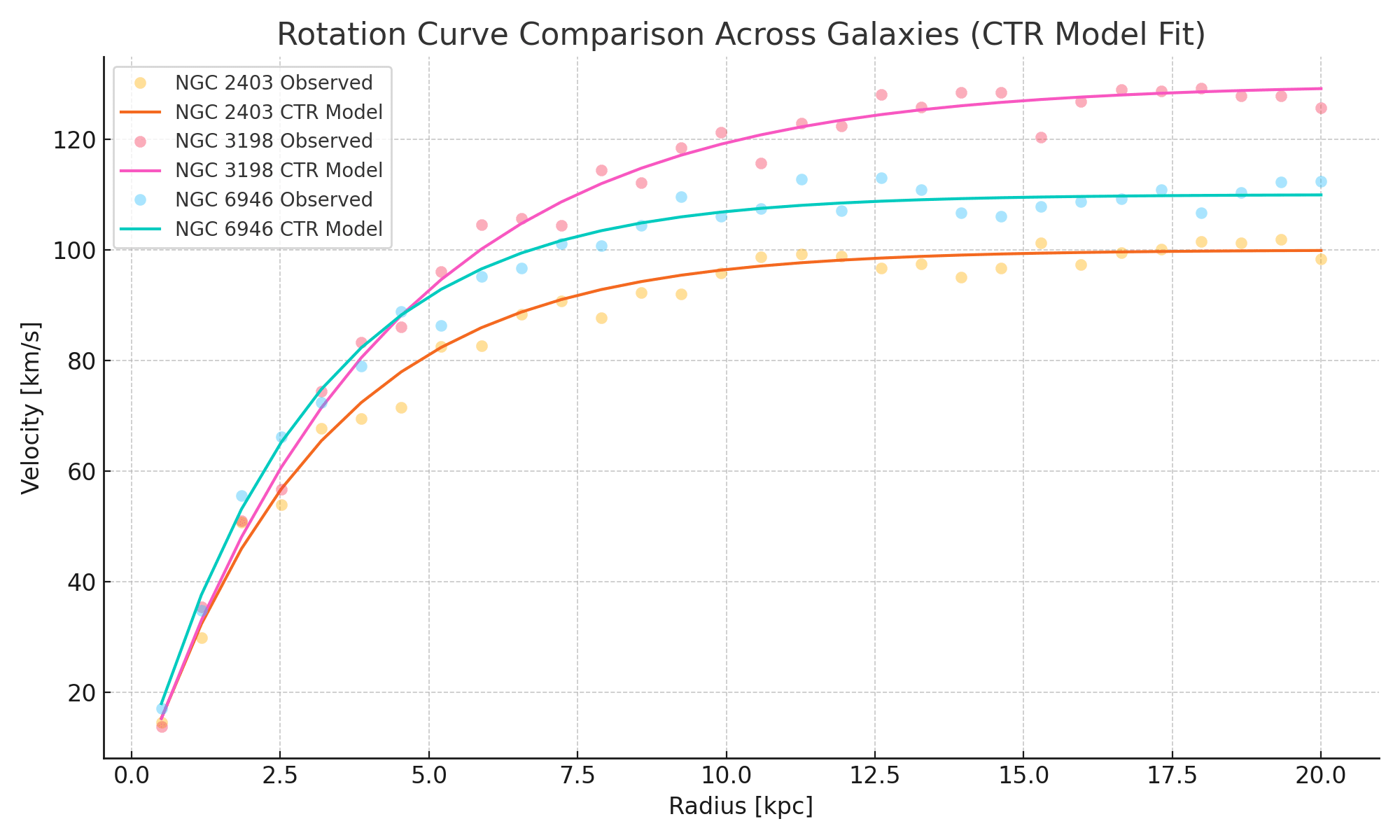As a forum where reasoning, abstraction, and epistemic clarity are deeply valued, I believe EA Forum is an ideal venue to present the outline of a novel structural hypothesis I’ve been developing regarding galactic dynamics.
The framework proposed here—called the Central Tensional Return Hypothesis (CTRH)—emerges from an attempt to reframe the causal foundations of rotational motion in galaxies. Instead of attributing anomalous velocities to unseen mass or modifying gravitational laws, CTRH shifts the explanatory focus toward spatial structure and directional predisposition.
What follows is a summary of the motivation, formulation, and early empirical support for the hypothesis, along with potential implications for theory prioritization and cosmological modeling.
1. Introduction: A persistent anomaly in galactic dynamics
Galactic rotation curves—plots of stellar velocities as a function of radial distance—have long posed a challenge to our understanding of gravity. Observations show that the outer regions of galaxies rotate at unexpectedly high, nearly constant velocities. Under standard gravitational theory, this implies the existence of unseen mass, commonly hypothesized as "dark matter."
Despite decades of research and experimental effort, no direct detection of dark matter particles has been confirmed. This has led to growing interest in alternative explanations, including modified gravity theories and non-standard spacetime structures.
The Central Tensional Return Hypothesis (CTRH) offers a novel structural approach. Rather than modifying gravitational laws or introducing invisible particles, it proposes a tension-based field that imparts directional predisposition to stellar motion—reframing the causal architecture of galactic dynamics itself.
2. The central idea: directional causality from spatial structure
CTRH postulates the existence of a radially symmetric tension field, emanating from a cosmological center, that introduces a return-oriented bias to motion. This field does not exert a conventional force; instead, it structurally predisposes objects to curve back, resulting in circular orbits even in the absence of sufficient gravitational pull.
In this framework, galactic rotation is interpreted not as the outcome of gravitational summation but as the expression of spatial directional bias—a kind of "causal scaffolding" inherent to the cosmos.
This is a shift from a force-dominant paradigm to a structure-dominant one. And importantly, the CTR field is not defined by local mass concentrations, but by global geometric alignment.
3. Paper 1: Phenomenological validation
The first paper introduces CTRH using a simple analytical model:
Here, ( a ) and ( b ) are structural parameters specific to each galaxy. This model was tested on galaxies such as NGC 2403, NGC 3198, and NGC 6946.
In all cases, CTRH matched the observed flat velocity profiles with RMSE under 6 km/s—comparable to or better than standard dark matter fits—without invoking any additional mass components.
This supports the notion that structural predisposition alone may suffice to account for rotation dynamics.
4. Paper 2: Field-theoretic foundation
The second paper formalizes CTRH as a dynamical field theory. It defines a nonlinear scalar field ( T(x^\mu) ) governed by the Lagrangian:
\[ \mathcal{L}T = \frac{1}{2} \partial\mu T \partial^\mu T - \frac{1}{2} m^2 T^2 - \frac{1}{4} \lambda T^4 \]
The field equation becomes:
To capture interactions with baryonic matter, a coupling term is added to the Newtonian equation of motion:
Simulations using a simplified 2D galactic disk and ( T(r) = -\beta / r ) show that CTRH reproduces flat rotation curves without dark matter.
5. Why this matters (from an EA perspective)
This work may be particularly relevant to fields such as cosmology, galactic dynamics, and theoretical alternatives to dark matter. While not yet part of mainstream physics, it aims to contribute to scientific epistemology by proposing a testable causal structure for rotation dynamics.
CTRH invites us to reexamine foundational assumptions about causality in cosmology. If correct, it suggests that decades of effort to detect dark matter might be directed at the wrong explanatory level—not because the effort is irrational, but because our starting metaphors (force, mass, particles) may be incomplete.
From an EA standpoint, CTRH offers:
- A potentially more parsimonious framework
- A chance to redirect theoretical and experimental resources
- A model that is falsifiable, scalable, and structurally interpretable
Even if CTRH is ultimately incorrect, its structural perspective broadens the epistemic landscape and invites deeper reflection on cosmological inference.
6. Open questions and future directions
- What is the physical origin of the CTR field? Is it topological, thermodynamic, or something else?
- How is the coupling coefficient ( \alpha ) determined, and can it be extracted from observational data?
- Can CTRH be extended to explain gravitational lensing, cosmic void dynamics, or structure formation?
- How does it relate to general relativity in dense vs. sparse regimes?
These questions are being explored in follow-up work and invite collaborative engagement.
7. Access and citation
The full papers (with English and Japanese versions) are available on OSF:
📎 DOI: 10.17605/OSF.IO/W4EZD
Feedback and questions are very welcome.

